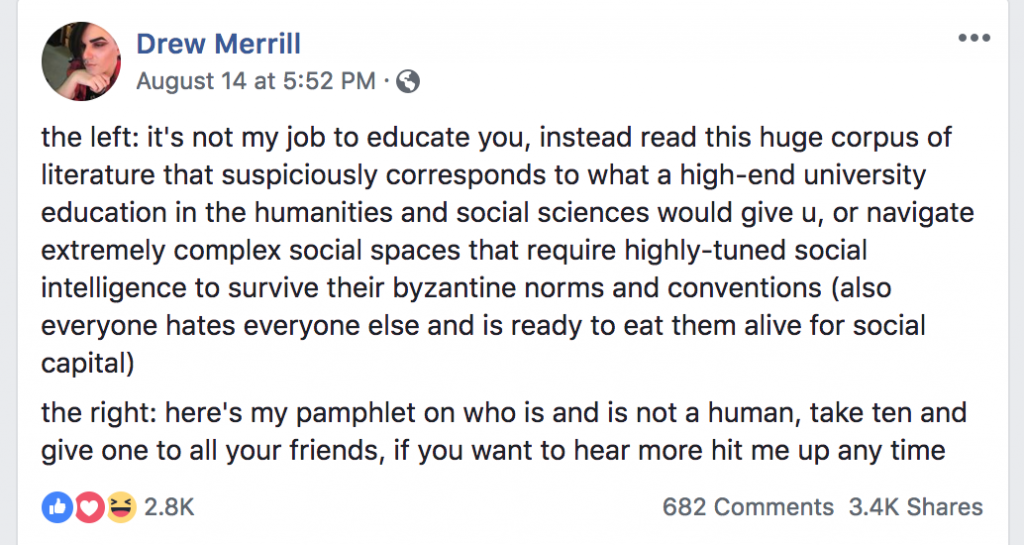Cynthia Wang of the Kellogg School at my alma mater, Northwestern University, has an academic interest in conspiracy thinking, and has engaged in a number of studies that have teased apart factors that influence the likelihood to conspiracy-mindedness. In a recent article, she suggests that people who feel disempowered or lacking in agency are more prone to finding conspiracies, both in the larger sense of what we think about as “conspiracy thinking” but also within their organizations. Wang’s prescription to address conspiracy mindedness is to work with the person to help them identify their goals and clear pathways to their goals, nurturing a sense of agency and personal control.
Wang’s insight adds nuance to the suggestion that conspiracy thinking is a reaction against a world that feels discordant and beyond control, a way to establish control when agency feels far away. Jessica Stillman at Inc.com suggests Wang’s approach as a way of engaging with folks who have been enfolded into the QAnon conspiracy phenomenon, to help them think about goals and concrete steps they can take in their life.
Overall, I agree that empowerment is a better move than arguing with the conspiracy itself. As we’ve learned through decades of research, once people form beliefs, those beliefs prove remarkably resilient even when they are factually disproven. Indeed there is evidence that arguing with someone’s belief using facts is more likely to reinforce that person’s belief than cause them to reflect and abandon it.
Factually countering something like a conspiracy theory is like trying to weed dandelions by cutting them off at the stem. Unless we get all the way to the root, the dandelion will simply grow back. To be truly effective, we need to look to the roots, which requires a measure of compassion.
What I find useful in such conversations is to recognize when we’ve become enmeshed in a battle for who defines reality and to pivot toward exploring the deeper motivations of the other person. The question I tend to use to do this pivot is some variation of, “(If all that you’re saying is true,) How does it affect you?” (The parenthetical comment is rarely spoken but for my own sake I remember that I am not necessarily embracing their reality.)
When pivoting in this way, we need to commit to moving toward genuine curiosity and concern. Most people, I find, intuitively sense this is a disarming move and respond with some measure of wariness. If there’s a sense that there is an agenda to use the information against them, they’re not going to open up. In a sense, this pivot is about letting go of the effort to argue about realities and to become curious about what in the other person’s life is engendering the powerlessness that has made their reality attractive.
If we can keep going, exploring where they feel powerless or stuck, we might be able to help simply by witnessing and caring about their feelings. Often this alone helps people to feel less isolated and overwhelmed, and helps them ground long enough to come up new ideas. You might ask if they’re interested in suggestions, or you might ask them more questions about where they feel stuck and if they have resources.
What Wang suggests, and I find to be true, is that when we help address the underlying powerlessness, anger, and fear, and help each other find our own power, then the need for a grand theory of our powerlessness becomes less important. We also have opportunities to create solidarity with each other, or offer other suggestions for concrete actions that build power.
Emotional Fatigue, Justice, and the Long Game
The merit of learning approaches like Wang’s is that it gives us another way to intervene when we are advocating for change and encounter people who are extremely hostile or appear to inhabit a separate sphere of reality. When we cannot follow each others’ intellectual labyrinths, we can move into the territory of the heart and will, which tend to be more relatable and accessible.
Debates about lizard people and time travel is not something I have any interest in, but I sure understand what it’s like to feel out of control and afraid about the way things are today. Instead of yelling at each other to think right or do better, we have an opportunity to help each other ground, remember what we want, and think about what paths are available to move toward that. From a public policy perspective, Wang’s insight points to the sense that much of our unrest today is rooted in a sense that our citizens do not know what is possible or how to pursue their goals.

When I suggest this work, I hear from folks who are annoyed that I am asking them to do more emotional labor, especially with people who are harming them or seem bound to ignore them. In the case of QAnon, it is apparent that popular QAnon beliefs are retreads of long-running anti-Semitic tropes. The whole story of child sacrifice, sex cults, harvesting the blood of innocents to drink for their vitalizing powers, secret cabals of wealthy people—these get dragged out in different clothes during periods of social crisis to make Jewish people the scapegoats of larger tensions
So am I asking Jewish people to be kind, thoughtful, and patient with QAnon supporters? No. I do not think anyone is obligated to coddle bigotry and scapegoating, especially not the people most impacted by it. And if someone has been striving to engage in the hard conversations and is feeling burnt out and tired of doing everyone else’s emotional work, I think it is better for the world if you focus on what restores your spirit and gives you strength and joy.
In the long run, I have always been more interested in effectiveness than what feels emotionally satisfying. And sometimes being effective looks like “losing,” letting a battle go or end, not adding that parting shot, not jumping to the attack of every bit of misinformation or every baiting comment. Sometimes being effective means learning to let go of the noise of the ideology and redirect attention to the emotional and material roots from which these beliefs have grown.
In working with misogynistic men, for example, it is not always effective to combat the misogynistic words directly. Instead, we may need to acknowledge and set aside the misogyny to seek out the unmet needs and feelings, the frustrations and the hurt. Once those deeper pains have been surfaced, we also discover the genuine urge for authentic connection, the genuine feelings of shame and guilt, and the possibility to help these men learn the skills they need to get these needs met for real.
Another critique, related to the first, is that it is easier for privileged people to engage in the work of meeting a hostile person where they’re at and helping them identify their emotional needs, which is true. I would clarify by pointing toward why privilege makes it easier—it’s easy for people not directly impacted to set aside the aggression of the attack and go to the deeper need. It’s easier for me as a non-Jewish person to be patient in conversation when I am not at existential threat from anti-Semitism. All the more reason for me to be the one to do this, when I have the resources.
I find the most persuasive conversations and movement happens when people can have honest conversations that are not polarizing, in which they feel heard and taken seriously—not necessarily their ideas, but the emotions beneath the ideas. I find these conversations really do not work in unmoderated public spaces like Facebook.
And also I find these days it seems like you only get social justice credibility when you call people out in public spaces where others can see. A long-term, supportive yet confrontational kind of relating feels unfashionable and uncomfortable because it means that there are times we might choose to preserve the relationship instead of a direct attack, or to address things in private.
For me, there are times I’ll wait until I sense the other person is open to hearing another perspective, and that could take a very long time. I do not always interrupt other people’s conversations and erode the relationship with arguments that are more likely to generate heat than light. I still make time to express my perspective in a space where I can set the frame for the conversation I want.
And in the meantime, a part of me wonders what I would do if someone called me out in a public post and demand I account for my relationship with a person they consider problematic. My way of relating invites mistrust that we are simply collaborating with people like us, and that is a risk.
Compassion is present, but compassion is not simply agreeing with everything a person says and making excuses because they’re having a hard week. What we see on the surface is not the entirety of the truth, and compassion gives us a pathway to the roots.
I don’t believe public arguments and call-outs are intrinsically wrong. They are different tactics that serve different purposes, and have value in situations where a personal connection is impossible to establish or dangerous, or the community needs protection when the subject of the call-out has proven they cannot be accountable in good faith. Without strength, kindness loses its potency. But without kindness, strength is simple cruelty.
Return to Power
In conclusion, I feel Wang’s insight is applicable to many of us right now. Across the political spectrum, I see our extreme manifestations of terror, anger, and despondency as reactions to the instability of the ground on which we stand, and feeling a lack of agency in life. Sinking into the feelings of powerlessness and overwhelm, remembering your goals, and figuring out what concrete steps you can take toward your own goals have all become more important since the election of 2016, and since the pandemic almost a daily necessity. The problems facing us seem so huge and insurmountable that it crushes us.
When we feel powerless, we are at risk of spinning out into anger, fear, and rage. We need to feel heard by someone who cares, who can then help us remember what agency we have in the world. If you can offer that to someone, that is wonderful. If you need that, think about who in your life might be able to offer that. If you cannot think of anyone, you might try the following:
Notice your relationship to the ground. Notice how the ground is supporting you right now, and see if you can start slowing your breathing down. As you inhale, notice the tension you’re carrying in your body. Notice what feelings you’re having. As you exhale, see if you can let the ground take more of that tension. See if you can sink into that which you’re sitting upon and let it hold your weight. Notice your back.
If you can, as you breathe in, imagine you can breathe into your belly center, our center of gravity and movement, a place of power in many traditions. Just breathe into your power, and let yourself be supported. Ask your body, what does it need right now? What would help?
If an answer comes, see if you can make a plan to move toward that.
If the answer seems impractical, ask yourself, how would I feel if I had this thing I need? And if you get an answer, imagine that you can breathe that feeling into your body. Imagine a time when you had that feeling, if needed, and see if you can give it room in yourself.
Think about something you want, and one concrete step you could take today that could move you toward that want. Even if that want would be impossible to accomplish today, there could be one thing you do that moves you toward it. It could be an incredibly simple, small step. Do an Internet search about it. Find a book about it. The smallest step is the best step.
If you can think of nothing else, look around your space for something you can clean, and clean it.

















